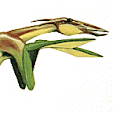My series of rusp posts have created something I never expected: an origami rusp. For more on rusps, simply start at the
previous post in this blog. Regular commenter Petr (Petr Stuchlý) has sculpted four models of Furahan animals in what for me is a novel medium: origami. He posted photos of one of them, the brontorusp, on
DeviantArt under the title of Xenorigami, which I rather like. Petr was kind enough to send me all four models in a neat package, which I appreciate very much.
 |
| Click to enlarge |
Let me show you the models. Here are all four of them along with a prototypical matchbox for size. Let me close in on all of them.
 |
| Click to enlarge |
First, of course, the origami model of the brontorusp (
Brontocrambis brucus). I have never published a complete image of the brontorusp, so Petr could not know that the front and hind heads are not identical. If you take a look at the image of the origami brontorusp on his DeviantArt page, you will see that the front and hind heads are identical. Once we got to talking about that he has made some changes to the model, and now the hind head no longer has a rostrum (snout). Before you ask about two-headedness (the Janus effect), here is an explanation. The basic ancestral rusp design involves developed segments with eyes on each one. When the lineage increased in complexity, 'cephalisation' set in, so nerve clusters, eyes, whips etc., concentrated in one spot leaving the animal with a head... Actually, no!. That may be what happens usually, but in rusp evolution there was not just an increase in complexity, but cephalisation also involved a loss of some functions, such as visions in middle segments. That, probably coupled with a need for defence on both ends of the rusp, stopped the loss of vision there, so there are eyes there, with a fully functional whip capable of giving any predator a good wallop. There is also a circular secondary brain, the neurannulinus, communicating -we assume!- with the neurannulus in front. There is no hind mouth though, so no rostrum there, and rusps definitely have a front and a hind part.
 |
| Click to enlarge |
Let's look at the details. I think that Petr caught the shape of the brontorusp's head very well. I have only a very vague idea of how you would go about to create such an intricate design from a square piece of paper of 50x50 cm. From his own comments (
"hell on earth to fold!!! XD") it was not exactly the easiest thing to do.
 |
| Click to enlarge |
The many folds at the rusp's bottom are interesting. Petr explained a particular featre as the result of his folding technique, but regardless of the cause the design parallels my rusp design in a surprising way. Rusps, as large animals, have vertically-orientated legs that swing forwards and backwards under the body, and not sideways, so there is a risk of them kicking one another. That problem was sidestepped (sorry for that one) by having the legs alternately offset to the centre or the side of the animal. The origami rusp has the same feature!
What you see here is the 'crease pattern' of the rusp laid out on a piece of paper. The 'CP' has lines indicating valleys and ridges, and helps the designer shape a flat piece of paper into a remarkably solid and three-dimensional sculpture.
 |
| Click to enlarge; bottom : copyright Gert van Dijk |
Petr has also made a hexapod neocarnicore, with its typical 'raptorial appendages'. The model captures the form well, which must be difficult as it is a very small model: he wanted to keep the models within a certain scale range. They are not fully in the same range, but I do not think I ever published enough data on exact rusp size for him or anyone else to judge the size accurately. Above is a new scale diagram for The Book, so you can see how large brontorusps are.
 |
| Click to enlarge |
A marshwallow! It is complete with three horns, and even seems to have the continually irritated expression that humans project on the animal's cranial features...
 |
| Click to enlarge |
And finally, two sides of the marblebill, here suspended from a Japanese eating stick, to stay in style. Origami paper can have one colour on one side and another on the other, and here that principle was obviously expanded by having a two-layered sheet of paper with metal foil on one side. Somehow Petr managed to have the dark paper end up on the dorsal side of the upper limbs and the metal side on the palmar side, doing justice to the pattern of the marblebill.
It is obvious that Petr is rather good at origami. If you wish to learn more about his art visit his
Flickr page,
DeviantArt page or a page at an
English origami site. If you like palaeontology, and the chances of that are high with a blog like this one, you should visit his page on origami versions of extinct animals.They're very good.











